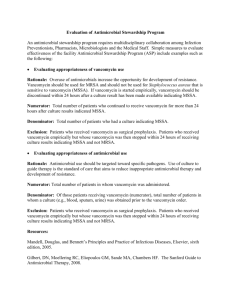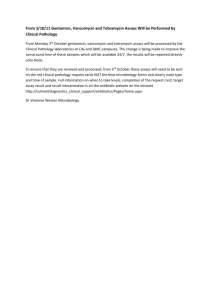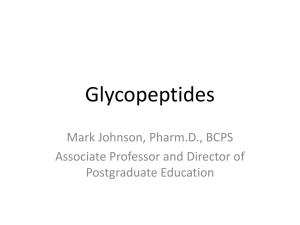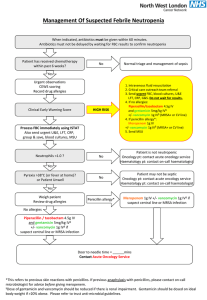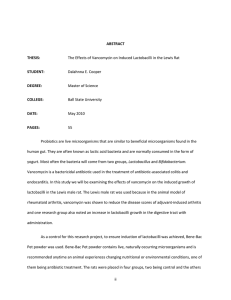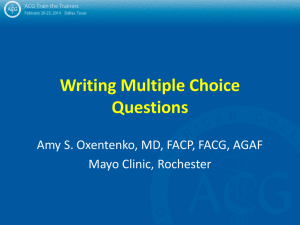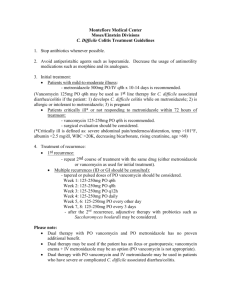Vancomycin Prescribing Practices in Hospitalized Chronic Hemodialysis Patients
advertisement
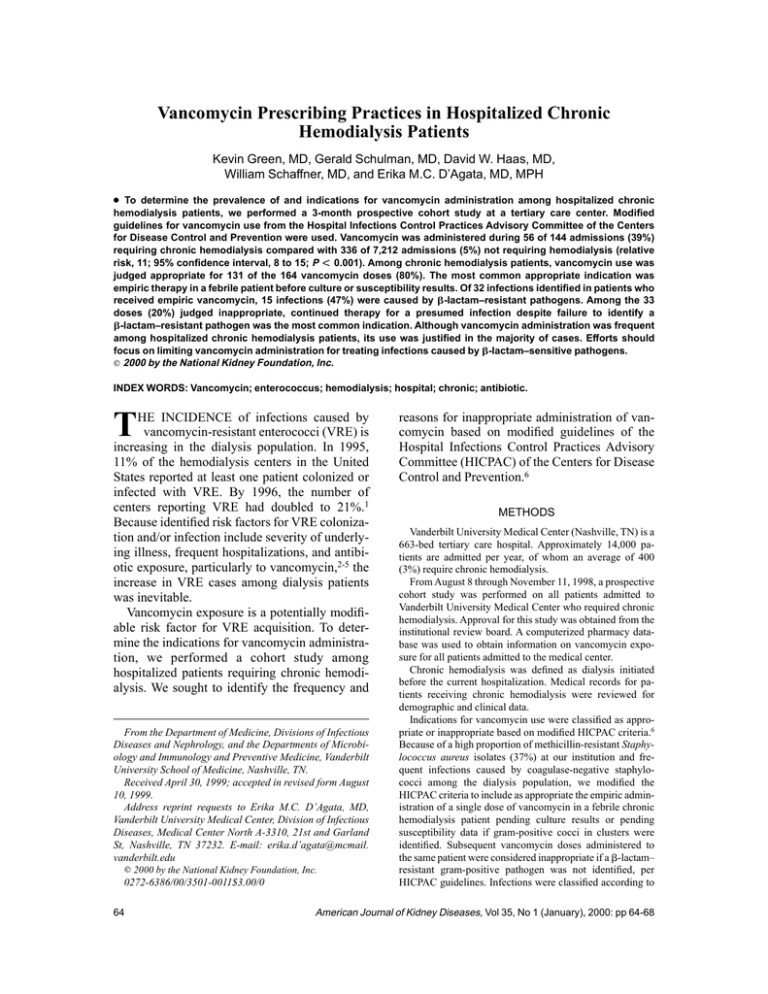
Vancomycin Prescribing Practices in Hospitalized Chronic Hemodialysis Patients Kevin Green, MD, Gerald Schulman, MD, David W. Haas, MD, William Schaffner, MD, and Erika M.C. D’Agata, MD, MPH ● To determine the prevalence of and indications for vancomycin administration among hospitalized chronic hemodialysis patients, we performed a 3-month prospective cohort study at a tertiary care center. Modified guidelines for vancomycin use from the Hospital Infections Control Practices Advisory Committee of the Centers for Disease Control and Prevention were used. Vancomycin was administered during 56 of 144 admissions (39%) requiring chronic hemodialysis compared with 336 of 7,212 admissions (5%) not requiring hemodialysis (relative risk, 11; 95% confidence interval, 8 to 15; P F 0.001). Among chronic hemodialysis patients, vancomycin use was judged appropriate for 131 of the 164 vancomycin doses (80%). The most common appropriate indication was empiric therapy in a febrile patient before culture or susceptibility results. Of 32 infections identified in patients who received empiric vancomycin, 15 infections (47%) were caused by -lactam–resistant pathogens. Among the 33 doses (20%) judged inappropriate, continued therapy for a presumed infection despite failure to identify a -lactam–resistant pathogen was the most common indication. Although vancomycin administration was frequent among hospitalized chronic hemodialysis patients, its use was justified in the majority of cases. Efforts should focus on limiting vancomycin administration for treating infections caused by -lactam–sensitive pathogens. 娀 2000 by the National Kidney Foundation, Inc. INDEX WORDS: Vancomycin; enterococcus; hemodialysis; hospital; chronic; antibiotic. T HE INCIDENCE of infections caused by vancomycin-resistant enterococci (VRE) is increasing in the dialysis population. In 1995, 11% of the hemodialysis centers in the United States reported at least one patient colonized or infected with VRE. By 1996, the number of centers reporting VRE had doubled to 21%.1 Because identified risk factors for VRE colonization and/or infection include severity of underlying illness, frequent hospitalizations, and antibiotic exposure, particularly to vancomycin,2-5 the increase in VRE cases among dialysis patients was inevitable. Vancomycin exposure is a potentially modifiable risk factor for VRE acquisition. To determine the indications for vancomycin administration, we performed a cohort study among hospitalized patients requiring chronic hemodialysis. We sought to identify the frequency and From the Department of Medicine, Divisions of Infectious Diseases and Nephrology, and the Departments of Microbiology and Immunology and Preventive Medicine, Vanderbilt University School of Medicine, Nashville, TN. Received April 30, 1999; accepted in revised form August 10, 1999. Address reprint requests to Erika M.C. D’Agata, MD, Vanderbilt University Medical Center, Division of Infectious Diseases, Medical Center North A-3310, 21st and Garland St, Nashville, TN 37232. E-mail: erika.d’agata@mcmail. vanderbilt.edu 娀 2000 by the National Kidney Foundation, Inc. 0272-6386/00/3501-0011$3.00/0 64 reasons for inappropriate administration of vancomycin based on modified guidelines of the Hospital Infections Control Practices Advisory Committee (HICPAC) of the Centers for Disease Control and Prevention.6 METHODS Vanderbilt University Medical Center (Nashville, TN) is a 663-bed tertiary care hospital. Approximately 14,000 patients are admitted per year, of whom an average of 400 (3%) require chronic hemodialysis. From August 8 through November 11, 1998, a prospective cohort study was performed on all patients admitted to Vanderbilt University Medical Center who required chronic hemodialysis. Approval for this study was obtained from the institutional review board. A computerized pharmacy database was used to obtain information on vancomycin exposure for all patients admitted to the medical center. Chronic hemodialysis was defined as dialysis initiated before the current hospitalization. Medical records for patients receiving chronic hemodialysis were reviewed for demographic and clinical data. Indications for vancomycin use were classified as appropriate or inappropriate based on modified HICPAC criteria.6 Because of a high proportion of methicillin-resistant Staphylococcus aureus isolates (37%) at our institution and frequent infections caused by coagulase-negative staphylococci among the dialysis population, we modified the HICPAC criteria to include as appropriate the empiric administration of a single dose of vancomycin in a febrile chronic hemodialysis patient pending culture results or pending susceptibility data if gram-positive cocci in clusters were identified. Subsequent vancomycin doses administered to the same patient were considered inappropriate if a -lactam– resistant gram-positive pathogen was not identified, per HICPAC guidelines. Infections were classified according to American Journal of Kidney Diseases, Vol 35, No 1 (January), 2000: pp 64-68 VANCOMYCIN USE IN DIALYSIS PATIENTS 65 Centers for Disease Control and HICPAC criteria.7,8 Pathogen identification and antimicrobial susceptibility testing were performed following guidelines of the National Committee for Clinical Laboratory Standards.9 Differences in vancomycin exposure among hemodialysis patients compared with nonhemodialysis patients were assessed using the chi-squared test. P of 0.05 or less was considered statistically significant (Stata Statistical Software, College Station, TX). RESULTS Vancomycin Administration During the 3-month study period, there were 7,356 hospital admissions. One hundred three patients required chronic hemodialysis during 144 admissions. Demographic and clinical data are listed in Table 1. Chronic hemodialysis patients received at least one dose of vancomycin during 56 of these admissions (39%). The mean number of doses received per patient was 2.9 (range, 1 to 10 doses), and the average dose of vancomycin administered was 0.85 g (median, 1 g; range, 0.25 to 2.25 g). For those patients who received at least two doses, the average interval between doses was 6 days (median, 3 days; range, 1 to 21 days). Among patients not requiring chronic hemodialysis, at least one dose of vancomycin was administered during 336 of 7,212 admissions (5%). Thus, patients requiring chronic hemodialysis received vancomycin significantly more often than those not requiring hemodialysis (relative risk, 11; 95% confidence interval, 8 to 15; P ⬍ 0.001). Table 1. Demographic and Clinical Data of Hospitalized Chronic Hemodialysis Patients Patient Characteristics Age (y) Sex (M:F) Race White Black Hispanic Underlying kidney disease Hypertension Diabetes mellitus Connective tissue disease Cyclosporine nephrotoxicity Other Mean length of hospital stay (d) No. of Patients (n ⫽ 103) 56 ⫾ 18 51:52 55 (53) 46 (45) 2 (2) 47 (46) 41 (40) 5 (5) 4 (4) 6 (6) 8 (1-75) NOTE. Values expressed as mean ⫾ SD, number (percent), or number (range). Table 2. Indications for Vancomycin Use Among Chronic Hemodialysis Patients Indications No. of Doses (n ⫽ 164) Appropriate Empiric therapy for a febrile patient on hemodialysis pending culture/susceptibility data* 73 (45) Treatment of -lactam–resistant organisms 51 (31) -Lactam allergy 5 (3) Surgical prophylaxis in patient with a prosthesis 2 (1) Endocarditis prophylaxis in high-risk patient 0 (0) Treatment of antibiotic-associated colitis if severe or after failure of metronidazole therapy 0 (0) Total 131 (80) Inappropriate Continued therapy despite negative cultures for -lactam–resistant organisms† 23 (14) Routine surgical prophylaxis 4 (2) Single positive blood culture for coagulasenegative staphylococci 1 (1) Empiric treatment for febrile patients with neutropenia unless evidence of gram-positive infection and prevalence of MRSA is substantial 0 (0) Prophylaxis for indwelling or peripheral intravascular catheters‡ 5 (3) Selective decontamination of digestive tract 0 (0) Eradication of MRSA colonization 0 (0) Primary treatment of antibiotic-associated colitis 0 (0) Routine prophylaxis of low-birth-weight infants 0 (0) Topical application 0 (0) Total 33 (20) NOTE. Values expressed as number (percent). Abbreviation: MRSA, methicillin-resistant Staphylococcus aureus. *Not included in HICPAC guidelines. †Includes HICPAC guideline: treatment of -lactam– sensitive organisms in patients with renal failure. ‡Includes HICPAC guideline: routine prophylaxis for dialysis patients. Indications for Vancomycin Administration Administration was judged appropriate for 131 of the 164 vancomycin doses (80%; Table 2). Seventy-three doses (median, 1 dose; range, 1 to 3 doses) were administered as empiric therapy to 42 febrile patients. Thirty-two infections were subsequently identified in 30 of these patients. Vancomycin was required for optimal therapy in 15 infections (47%). The types of infections and pathogens are listed in Table 3. Of the 26 doses 66 GREEN ET AL Table 3. Type of Infections and Pathogens Among 30 Febrile Chronic Hemodialysis Patients Prescribed Empiric Vancomycin Type of Infection Pathogen Total (n ⫽ 32) Bacteremia (n ⫽ 17) Local Catheter (n ⫽ 5) Intra-Abdominal (n ⫽ 5) Other (n ⫽ 5) Methicillin-resistant Staphylococcus aureus* Coagulase-negative Staphylococcus spp* Methicillin-susceptible S aureus Enterobacter cloacae Candida spp Pseudomonas aeruginosa Diphtheroids† Other† 8 6 4 3 3 1 1 6 5 4 2 1 0 1 0 3 1 2 1 0 0 0 1 0 2 0 1 0 1 0 0 1 0 0 0 2 2 0 0 2 *Vancomycin required for optimal therapy. †Two infections or less per species. administered as empiric therapy in which an infection was not identified, cultures were not obtained before five doses among five patients, and cultures were subsequently negative after a total of 21 doses among seven patients. Administration of vancomycin was judged inappropriate for 33 of the doses (20%; Table 2). Twenty-three doses were administered to nine patients for continued therapy of a presumed infection despite failure to identify a -lactam– resistant gram-positive pathogen. Pathogens identified from cultures before administering 21 of these doses were as follows: -lactam–susceptible gram-positive organisms (11 doses), Enterobacter cloacae (4 doses), Pseudomonas aeruginosa (2 doses), VRE (2 doses), Streptococcus spp (1 dose), and Candida spp (1 dose). Pathogens were not identified before two vancomycin doses administered to two patients. Although these patients met the criteria for inappropriate vancomycin administration, one patient received vancomycin for a presumed tunneled-catheter infection in view of erythema and tenderness at the catheter site; cultures of the wound site were negative. The second patient received vancomycin for a community-acquired pneumonia with negative sputum cultures. DISCUSSION This study demonstrates that hospitalized chronic hemodialysis patients receive vancomycin significantly more often than other hospitalized patients. Furthermore, 80% of vancomycin doses administered to chronic hemodialysis patients were judged appropriate. Since the publication of the HICPAC guidelines for appropriate vancomycin use, several studies have addressed physician compliance with these recommendations among the general hospital population, with appropriate administration ranging from 21% to 59%.10-15 In the present study, appropriate administration of vancomycin was considerably more frequent and reflects the use of modified guidelines. In view of the high rate of -lactam–resistant gram-positive pathogens in the dialysis population, empiric therapy for febrile patients or for patients with positive cultures for gram-positive cocci in clusters, pending susceptibility data, was considered an appropriate use of vancomycin. This modification was clearly appropriate because 47% of infections in patients who received vancomycin empirically were caused by -lactam–resistant gram-positive pathogens, two thirds of which were implicated in blood-stream infections. If this modification was not included, only 35% of vancomycin doses would have been considered appropriate based on strict interpretation of HICPAC guidelines. Vancomycin use was judged inappropriate for 20% of doses, the majority of which were administered for treatment of -lactam–sensitive grampositive pathogens. This percentage may be greater in outpatient hemodialysis centers in which the convenience of longer dosing intervals of vancomycin may prevail. Regardless of the VANCOMYCIN USE IN DIALYSIS PATIENTS setting, vancomycin should not be used to treat infections caused by -lactam–sensitive grampositive pathogens for several reasons. First, it is important to reduce the overall vancomycin exposure to minimize the incidence of VRE, which are major causes of morbidity and mortality. Of possibly greater concern is the recent emergence of S aureus with decreased susceptibility to vancomycin. Since 1996, four patients with S aureus with reduced susceptibility to vancomycin have been reported, three of whom were receiving dialysis therapy and had received prolonged courses of vancomycin.16-18 Thus, the judicious use of vancomycin in dialysis patients cannot be overemphasized. Second, vancomycin is not the preferred antimicrobial agent for treating infections caused by -lactam–sensitive gram-positive organisms because several studies have shown that vancomycin is less efficacious than -lactam antibiotics against -lactam–susceptible staphylococci.19-22 The HICPAC guidelines provide a framework to assist physicians in deciding when to prescribe vancomycin. These guidelines, however, require prudent interpretation and modification based on the individual clinical situation. In the present study, two doses of vancomycin were administered to patients who had negative culture results and thus did not meet the HICPAC criteria for appropriate vancomycin administration. Both patients, however, had evidence of active infection. Because cultures may fail to identify the causative pathogen,23 administration of vancomycin is not always inappropriate in these cases. In summary, the present study shows that vancomycin use is frequent among hospitalized chronic hemodialysis patients and that its use is justified in the large majority of cases. Nevertheless, ongoing efforts to limit vancomycin exposure in the chronic hemodialysis population is of utmost importance, especially in patients who do not require empiric antimicrobial therapy. REFERENCES 1. Tokars JI, Miller ER, Alter MJ, Arduino MJ: National Surveillance of Dialysis-Associated Disease in the United States, 1996. Atlanta, GA, Public Health Service, Department of Health and Human Services, 1998, pp 1-59 2. Handwerger S, Raucher B, Altarac D, Monka J, Marchione S, Singh KV, Murray BE, Wolff J, Walters B: Nosocomial outbreak due to Enterococcus faecium highly resistant to vancomycin, penicillin, and gentamicin. Clin Infect Dis 16:750-755, 1993 67 3. Ostrowski B, Venkataraman L, D’Agata E, Gold H, DeGirolami P, Samore M: Vancomycin-resistant enterococci in intensive care units: High frequency of stool carriage during non-outbreak periods. Arch Intern Med 159:14671472, 1999 4. Edmond MB, Ober JF, Weinbaum DL, Pfaller MA, Hwang T, Sanford MD, Wenzel RP: Vancomycin-resistant Enterococcus faecium bacteremia: Risk factors for infection. Clin Infect Dis 20:1126-1133, 1995 5. Henning KJ, Delencastre H, Eagan J, Boone N, Brown A, Chung M, Wollner N, Armstrong D: Vancomycinresistant Enterococcus faecium on a pediatric oncology ward: Duration of stool shedding and incidence of clinical infection. Pediatr Infect Dis J 15:848-854, 1996 6. Hospital Infection Control Practices Advisory Committee: Recommendations for preventing the spread of vancomycin resistance. Infect Control Hosp Epidemiol 16:105-113, 1995 7. Garner JS, Jarvis WR, Emori TG, Horan TC, Hughes JM: CDC definitions for nosocomial infections. Am J Infect Control 16:128-140, 1988 8. Pearson ML, the Hospital Infection Control Practices Advisory Committee: Guidelines for prevention of intravascular device-related infections. Am J Infect Control 24:262293, 1996 9. Murray PR, Baron EJ, Pfaller MA, Tenover FC, Yolken RH: Manual of Clinical Microbiology (ed 6). Washington, DC, American Society for Microbiology Press, 1995, pp 1327-1343 10. Watanakunakorn C: Prescribing pattern of vancomycin in a community teaching hospital with low prevalence of vancomycin-resistant enterococci. Infect Control Hosp Epidemiol 18:767-769, 1997 11. Singer MV, Haft R, Barlam T, Aronson M, Shafer A, Sands K: Vancomycin control measures at a tertiary-care hospital: Impact of interventions on volume and patterns of use. Infect Control Hosp Epidemiol 19:248-253, 1998 12. Johnson SV, Hoey LL, Vance-Bryan K: Inappropriate vancomycin prescribing based on criteria from the Centers for Disease Control and Prevention. Pharmacotherapy 15: 579-585, 1995 13. Logsdon BA, Lee KR, Luedtke G, Barrett FF: Evaluation of vancomycin use in a pediatric teaching hospital based on CDC criteria. Infect Control Hosp Epidemiol 18:780-782, 1997 14. Anglim AM, Klym B, Byers KE, Scheld WM, Farr BM: Effect of a vancomycin restriction policy on ordering practices during an outbreak of vancomycin-resistant Enterococcus faecium. Arch Intern Med 157:1132-1136, 1997 15. Evans ME, Kortas KJ: Vancomycin use in a university medical center: Comparison with hospital infection control practices advisory committee guidelines. Infect Control Hosp Epidemiol 17:356-359, 1996 16. Centers for Disease Prevention and Control: Reduced susceptibility to Staphylococcus aureus to vancomycin— Japan, 1997. MMWR 46:626-626, 1997 17. Sieradzki K, Roberts RB, Haber SW, Tomasz A: The development of vancomycin resistance in a patient with methicillin-resistant Staphylococcus aureus infection. N Engl J Med 340:517-523, 1999 18. Smith TL, Pearson ML, Wilcox KR, Cruz C, Lan- 68 caster MV, Robinson-Dunn B, Tenover FC, Zervos MJ, Band JD, White E, Jarvis WR: Emergence of vancomycin resistance in Staphylococcus aureus. Glycopeptide-Intermediate Staphylococcus aureus Working Group. N Engl J Med 340:493-501, 1999 19. Korzeniowski O, Sande MA, the National Collaborative Endocarditis Study Group: Combination antimicrobial therapy for Staphylococcus aureus endocarditis in patients addicted to parenteral drugs and in nonaddicts: A prospective study. Ann Intern Med 97:496-503, 1982 20. Chambers HF, Miller RT, Newman MD: Two-week GREEN ET AL combination therapy of right-sided Staphylococcus aureus endocarditis in intravenous drug abusers. Ann Intern Med 109:619-624, 1988 21. Karchmer AW: Staphylococcus aureus and vancomycin: The sequel. Ann Intern Med 115:739-740, 1991 22. Small PM, Chambers HF: Vancomycin for Staphylococcus aureus endocarditis in intravenous drug users. Antimicrob Agents Chemother 34:1227-1231, 1990 23. Greenaway CA, Embil J, Orr PH, McLeod J, Dyck B, Nicolle LE: Nosocomial pneumonia on general medical and surgical wards in a tertiary-care hospital. Infect Control Hosp Epidemiol 18:749-756, 1997
